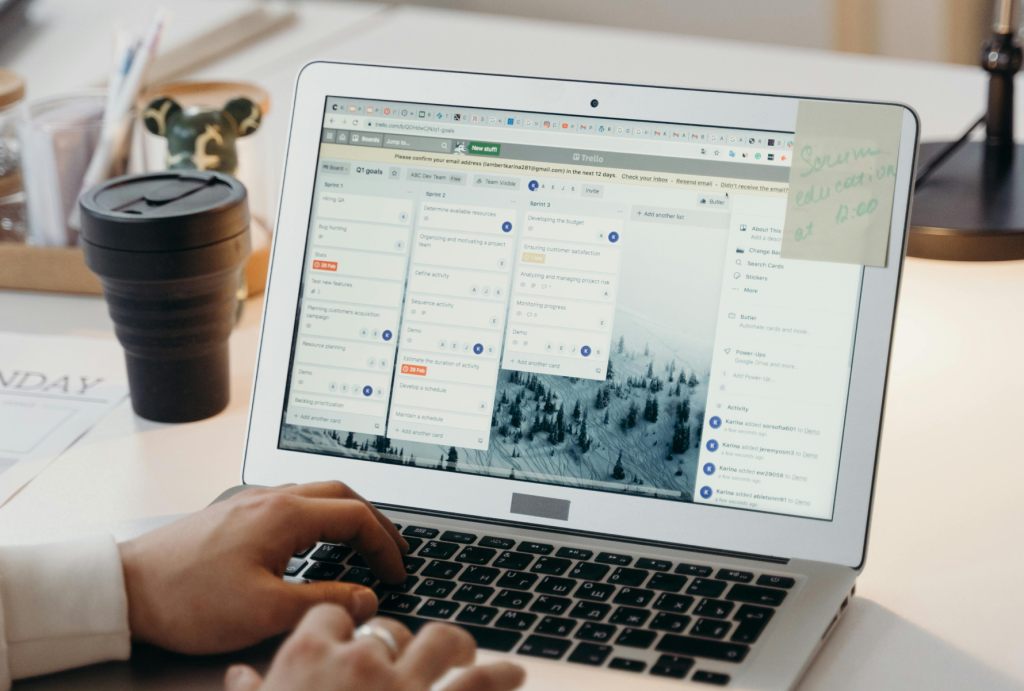With an increasing number of individuals seeking accessible mental health support, the digital health space has become a noticeable component of the healthcare industry.
According to a report by Grand View Research, the global mental health app market is expected to reach $17.5 billion by 2030, growing at a CAGR of 17.6% from 2023 to 2030. This substantial growth highlights the urgent need for entrepreneurs and developers to understand the specifics of building mental health apps.
Exploring Different Types of Mental Health Apps
Understanding the various types of mental health apps is essential for successful mental health app development. Let’s highlight the core functionalities of such apps.
Therapy Apps
Therapy apps connect users with licensed mental health professionals, providing accessible and flexible support options.
Key Features:
- Secure Communication Channels: Offer various modes of interaction such as video calls, voice calls, and messaging while ensuring data privacy through robust encryption protocols compliant with HIPAA compliance mental health apps standards.
- Appointment Scheduling: Integrated calendars and reminders to streamline booking and managing therapy sessions.
- Progress Tracking: Tools that allow users and therapists to monitor mental health progress over time, facilitating continuous improvement in apps.
- Resource Libraries: Access to articles, exercises, and other materials to support users between sessions.
Technical Considerations:
- Data Security and Privacy: Implementing stringent security measures to protect sensitive user information, adhering to regulations like GDPR and health apps compliance.
- Reliable Infrastructure: Ensuring stable and high-quality real-time communication through a robust technology stack for health apps.
- Cross-Platform Compatibility: Developing for multiple platforms to reach a wider audience, utilizing either native app development mental health approaches for optimal performance or cross-platform development for efficiency.
- Scalability: Designing the app architecture to handle increasing user loads without compromising performance, crucial for effective app development project management.
Mindfulness and Meditation Apps
Mindfulness and meditation apps help users manage stress, improve focus, and enhance overall well-being through guided practices and exercises.
Key Features:
- Diverse Meditation Libraries: Add a wide range of guided meditations catering to different needs such as stress relief, sleep improvement, and anxiety reduction.
- Personalized Recommendations: Utilize user data and preferences to suggest relevant content, enhancing user engagement strategies and promoting retention.
- Progress and Goal Tracking: Develop features that allow users to set goals and monitor their mindfulness journey over time.
- Offline Access: Enable users to download sessions for uninterrupted practice regardless of internet connectivity.
Technical Considerations:
- High-Quality Audio and Visuals: Ensure exceptional content delivery to provide a calming and immersive user experience.
- Analytics Integration: Incorporate app analytics to monitor usage patterns and inform future mental health related content and feature developments.
- Cost-Effective Development: Balance quality and costs through strategic choices in the mobile app development process. Practice has shown that the Agile approach is a great option for mental health applications.
Mood Tracking Apps
Mood tracking apps assist users in monitoring and understanding their emotional patterns.
Key Features:
- Daily Mood Logs: Offer simple and intuitive interfaces for users to record their moods regularly.
- Visual Data Representation: Implement charts and graphs that depict mood trends over time, providing clear insights into emotional well-being.
- Journal Integration: Allow users to add notes alongside mood logs for context.
- Customizable Notifications: Add reminders to encourage consistent use, boosting health app engagement metrics.
Technical Considerations:
- Data Security: Ensure all user data is securely stored and handled, complying with relevant mental health app regulations and data protection laws.
- Seamless User Experience: Design an intuitive and user-friendly UI/UX of your mental health app to encourage regular interaction.
- Integration Capabilities: Allow synchronization with other health devices and apps for a comprehensive view of the user’s condition.
Self-Care Apps
Self-care apps empower users to take proactive steps in managing their mental health through activities and routines that promote well-being.
Key Features:
- Habit Building Tools: Design features that help users establish and maintain healthy routines.
- Educational Resources: Provide easy access to information and tips on various self-care practices and mental health topics.
- Personalized Plans: Customize self-care plans based on user inputs and preferences.
- Community Support: Provide a possibility to share experiences, fostering a sense of connection and belonging.
Technical Considerations:
- Personalization Algorithms: Utilize AI to tailor content and recommendations.
- Interactive and Engaging Design: Create an appealing and interactive design for your mental health app to keep users engaged and motivated.
- Performance Optimization: Ensure the app runs smoothly across different devices.
- Monetization Strategies: Develop sustainable revenue models while keeping the app ROI attractive for investors and stakeholders.
Compliance and Ethical Considerations in Mental Health App Development

When developing a mental health app, ensuring compliance with relevant regulations and adhering to ethical standards are paramount. These measures protect user data and build trust with your audience.
HIPAA Compliance for Mental Health Apps
For mental health apps operating in the United States, HIPAA compliance is a critical requirement.
- Data Encryption: All personal health information (PHI) must be encrypted both at rest and in transit to prevent unauthorized access.
- Access Controls: Implement strict access controls ensures that only authorized personnel can access PHI. This includes using multi-factor authentication (MFA) and role-based access control (RBAC).
- Audit Trails: Maintain detailed logs of all access and changes to PHI for data usage
- User Consent: Ensuring that users provide explicit consent before their data is collected, stored, or shared is a fundamental requirement.
GDPR and Health Apps: Ensuring Data Privacy in Europe
For apps targeting users in the European Union, GDPR compliance is essential.
- Data Minimization: Only collect and process data that is strictly necessary for the app’s functionality.
- User Rights: Give users the right to access, correct, or delete their data.
- Data Breach Notifications: In the event of a data breach, notify affected users and relevant authorities within 72 hours.
Ethical Considerations: Building Trust with Users
Beyond regulatory compliance, mental health app development includes important ethical considerations.
Informed User Consent
One of the most critical ethical aspects is ensuring that users provide informed consent before their data is collected or used. This means that users should fully understand:
- What data is being collected
- How the data will be used
- Data sharing practices
Transparent Data Usage and Ethical Data Management
In addition to obtaining consent, ethical data management practices are crucial for maintaining user trust. This includes:
- Transparency in Data Usage
- Data Anonymization
- Regular Security Audits
Addressing the Ethical Challenges of Mental Health Apps
Given the sensitive nature of mental health data, developers must also consider the broader ethical implications of their apps.
- Avoiding Harm
- Promoting Inclusivity
- Supporting User Autonomy
Choosing the Right Technologies for Mental Health App Development

Native vs. Cross-Platform Development
One of the first decisions you’ll need to make when creating a mental health app is whether to opt for native or cross-platform app development. Each approach has its own advantages and drawbacks, and the choice largely depends on your specific app requirements, target audience, and budget.
Native App Development: Optimal Performance and User Experience
Native app development involves creating separate versions of your app for each mobile operating system, typically iOS and Android. This approach is often preferred when performance and user experience are top priorities.
Advantages:
- Superior Performance: Native apps are built using the platform’s specific programming languages (Swift for iOS, Kotlin for Android), which allows for faster execution and smoother operation.
- Enhanced User Experience: Native apps can fully leverage the device’s hardware and operating system features, resulting in a more seamless and responsive user experience. This is particularly important for the UI/UX of your mental health app.
- Better Integration: Native apps can easily integrate with other native services and APIs.
Drawbacks:
- Higher Development Costs: Developing and maintaining two separate codebases (one for iOS and one for Android) is more costly and time-consuming.
- Longer Time to Market: Due to the need for separate development processes, native apps often have a longer app development timeline.
Cross-Platform Development: Efficiency and Cost-Effectiveness
Cross-platform development allows developers to create a single codebase that runs on multiple operating systems, such as iOS and Android. This approach is ideal for projects where time and budget constraints are significant considerations.
Advantages:
- Cost Efficiency: By using a single codebase, development costs are significantly reduced, making this approach more suitable for startups or projects with limited budgets, such as bootstrap mental health app projects.
- Faster Development: With cross-platform development, you can reach both iOS and Android users simultaneously, reducing the time to market of your mental health app.
- Wider Reach: A cross-platform app allows you to target a broader audience right from the start.
Drawbacks:
- Potential Performance Trade-offs: While modern cross-platform frameworks have improved, there can still be performance limitations compared to native apps.
- Limited Access to Native Features: Cross-platform apps might not fully utilize all the native features of each operating system.
Recommendations for a Scalable, Robust, and Secure Technology Stack
Once you’ve chosen between native and cross-platform development, the next step is to select the specific technologies and tools that will form your app’s technology stack. Here are some recommendations to consider.
Scalability
Scalability is essential for a mental health app, especially if you anticipate a growing user base. Choose technologies that support scalability ensure your app can handle increased traffic and feature expansion without compromising performance.
Recommended Stack:
- Backend Frameworks: Consider Node.js or Django. These frameworks are known for their ability to handle high traffic and support rapid scaling.
- Cloud Services: Utilize cloud platforms like AWS, Google Cloud, or Azure to easily scale your infrastructure.
- Microservices Architecture: Adopt a microservices architecture to enhance scalability by breaking down the app into smaller, independently deployable services.
Robustness
Robustness refers to the app’s ability to function reliably under various conditions. A robust app is less likely to crash or experience downtime, which is particularly important for users who rely on your app for mental health support.
Recommended Stack:
- Programming Languages: For native development, Swift (iOS) and Kotlin (Android) are highly recommended due to their stability and performance. For cross-platform development, frameworks like React Native or Flutter offer robust performance with a shared codebase.
- Database Management: Choose a reliable database system like PostgreSQL or MongoDB that can handle large volumes of data.
- Error Handling: Implement comprehensive error handling and logging mechanisms to detect and address issues before they impact the user experience.
Security
Security is a non-negotiable aspect of mental health app development, given the sensitivity of the data involved.
Recommended Stack:
- Encryption: Implement end-to-end encryption for all data transmissions to protect user information from unauthorized access. Libraries like OpenSSL can be used to encrypt data at rest and in transit.
- Authentication and Authorization: Utilize robust authentication mechanisms such as OAuth 2.0 for secure user login and session management. Multi-factor authentication (MFA) should be considered to add an extra layer of security.
- Security Frameworks: Incorporate security frameworks such as OWASP to identify and mitigate potential security risks throughout the development process.
- Compliance Tools: Use compliance management tools to ensure that your app adheres to regulatory requirements.
Designing for User Engagement and Retention

User-centric design is the foundation of a successful mental health app. It focuses on understanding the user’s needs, preferences, and behaviors, ensuring that every aspect of the app’s design caters to creating a seamless and supportive experience.
Key Principles of User-Centric Design
- Empathy and Understanding: Start with thorough user research to gain a deep understanding of the challenges your target audience faces. By empathizing with users, you can design an app that genuinely supports their mental health journey. For instance, a UI/UI that is calming, easy to navigate, and non-intrusive can significantly enhance user satisfaction.
- Simplicity and Clarity: The design should prioritize ease of use, minimizing cognitive load.This is especially important in a mental health context, where users may already be dealing with stress or anxiety. A straightforward design can make the app more accessible and inviting.
- Accessibility: Ensuring that the app is accessible to users with varying abilities is essential. This includes considerations like text size adjustments, screen reader compatibility, and easy navigation.
- Emotional Design: Colors, typography, and imagery should evoke the right emotions. For example, using soothing colors and gentle animations can help create a sense of peace, which is crucial in a mental health app.
Strategies to Boost User Retention
User retention reflects the ongoing value that users derive from the app. Here are some effective strategies to keep users coming back.
Personalized User Experiences
Personalization is key to making users feel that the app is tailored to their specific needs.
- Customized Content: Utilize app analytics to understand user preferences and behaviors. This data can be used to suggest relevant content, such as specific mental health exercises, improving the app’s relevance to each user.
- Adaptive User Interface: Design the app interface to adapt based on user interaction patterns. For example, frequently used features could be more prominently displayed, making the app more intuitive.
- Targeted Notifications: Implement push notifications that are personalized to the user’s habits and needs. For instance, sending a gentle reminder to log their mood at the same time each day can encourage regular use without being intrusive.
Push Notifications
Push notifications, when used correctly, can be a powerful tool for maintaining health app engagement metrics.
- Timeliness and Relevance: Notifications should be sent at times when the user is most likely to engage, based on their usage patterns.
- Motivational Messages: Encourage users by sending positive reinforcement and reminders of the benefits of regular app use.
- Customizable Settings: Allow users to choose their notification preferences, including frequency and types of notifications.
Gamification: Making the Experience Engaging and Fun
Gamification can transform routine tasks into engaging activities, thereby increasing user retention.
- Progress Tracking: Implement features that allow users to track their progress, such as streaks for consecutive days of meditation or mood logging. Rewarding users with badges or points can encourage continued use.
- Challenges and Goals: Introduce challenges that users can participate in, such as a 30-day meditation challenge. This can provide a sense of accomplishment and community, encouraging users to return to the app regularly.
- Social Sharing: Allow users to share their achievements with friends or within a community. Social sharing can create a sense of accountability and motivate users to stay engaged with the app.
Development Strategy and Project Management

The methodologies you choose will shape the entire development process, affecting timelines, costs, and the app’s adaptability to changing user needs. Here we will explore the benefits and drawbacks of Agile and Waterfall methodologies in the context of app development, and discuss the advantages of starting with a Minimum Viable Product (MVP) to test the market and iterate based on user feedback.
Agile vs. Waterfall
When planning the development of a mental health app, selecting the right project management methodology can significantly impact the outcome. The two most common methodologies are Agile and Waterfall, each with its own set of benefits and challenges.
Agile Development Methodology
Agile development is a flexible and iterative approach that allows for continuous feedback and adjustment throughout the development process. It is particularly well-suited for projects where requirements may evolve over time or when user feedback is crucial.
Benefits:
- Flexibility and Adaptability: Agile allows for frequent reassessment of project goals and features. This is particularly beneficial in mental health app development, where user needs and market conditions can change rapidly.
- User-Centric Development: Agile methodologies emphasize user feedback, enabling the development team to make adjustments based on actual user experiences and preferences. This iterative process helps in refining the app design and improving user engagement strategies.
- Continuous Improvement: Agile promotes a cycle of continuous improvement, ensuring that the app evolves in response to user feedback and market trends. Such an approach aligns well with the goal of maintaining high user retention over time.
- Faster Time to Market: By breaking the project into smaller, manageable sprints, Agile enables quicker releases.
Drawbacks:
- Resource Intensity: Agile requires continuous involvement from the development team and stakeholders, which can be resource-intensive.
- Scope Creep: The flexibility of Agile can sometimes lead to scope creep, where new features are added beyond the original plan, potentially delaying the project or increasing costs.
Waterfall Methodology
Waterfall methodology is a linear and sequential approach to project management, where each phase of development must be completed before moving on to the next. This method is often used in projects with well-defined requirements and a clear path from start to finish.
Benefits:
- Clear Structure: Waterfall’s linear approach provides a clear and structured plan, making it easier to manage and track progress. This can be beneficial in mental health app project management where clarity and predictability are priorities.
- Defined Requirements: Since the entire scope of the project is defined upfront, Waterfall is less prone to changes and modifications during development. This can reduce the risk of scope creep and help in maintaining the app development timeline.
- Easier Budget Management: With a clearly defined project scope, budget estimates tend to be more accurate and easier to manage.
Drawbacks:
- Inflexibility: Adjustments or changes typically require revisiting earlier stages, which can be costly and time-consuming.
- Delayed User Feedback: Because testing and user feedback usually occur late in the development process, there is a risk that significant issues or unmet needs may not be discovered until the app is nearly complete.
The Advantage of Starting with an MVP

An MVP is a simplified version of the app that includes only the core features necessary to meet the primary needs of early users.
Benefits of an MVP
- Market Testing: By releasing a basic version of the app, you can gauge user interest and validate the app’s concept before committing to a full-scale launch. This approach helps in understanding the mental health app market fit and can guide further development.
- User Feedback Integration: With an MVP, you can gather early user feedback, which is invaluable for refining the app. This feedback loop enables you to adjust features, improve UI/UX of your mental health app.
- Faster Time to Market: An MVP can be developed and launched quickly, allowing you to enter the market sooner and start building a user base. This early presence in the market can provide a competitive advantage and help secure funding for mental health startups.
- Cost-Effectiveness: By focusing on the essential features, an MVP requires fewer resources and a smaller budget. This approach can be particularly advantageous for startups operating with limited funds, helping to manage the overall cost to develop a mental health app.
Drawbacks of an MVP
- Limited Features: Users might perceive the app as incomplete, which could impact its early reputation.
- Risk of Misalignment: If the initial set of features in the MVP does not align well with user needs, there is a risk of negative feedback that could harm the app’s brand image.
Time and Cost Estimation for Mental Health App Development

Pre-Development Phase (1-3 Months)
The pre-development phase sets the stage for the entire project and is critical for ensuring that the app is well-positioned for success.
Key Activities:
- Market Research: Conducting comprehensive market research to understand user needs, competitor offerings, and market gaps. This step typically takes about 1-2 months.
- Compliance Planning: Ensuring that the app will comply with relevant regulations, such as HIPAA and GDPR compliance. Depending on the complexity of these requirements, this can take an additional 1-2 months.
- Initial Design: Developing initial mental health app design concepts, including mental health app UI/UX design can take 1-2 months.
Time Estimate:
1-3 months depending on the complexity of the app and the thoroughness of the research and planning required.
Cost Considerations:
- Market Research: Costs vary depending on the depth of research. Engaging a professional market research firm can be expensive but provides valuable insights. Alternatively, conducting in-house research may reduce costs but could extend the timeline.
- Compliance Planning: Legal and compliance consulting fees can be significant, particularly for apps that need to adhere to stringent regulations.
- Initial Design: Costs for this phase depend on the experience and location of the design team. Designers in regions with a higher cost of living typically charge more.
Development Phase (3-6 Months)
The development phase involves the actual creation of the app, including programming, user interface creation, and backend setup. This is the most resource-intensive phase and requires careful project management to stay on schedule and within budget.
Key Activities:
- Programming: Writing the code for the app, which includes both frontend and backend development. Depending on the complexity of the features, this can take 2-4 months.
- User Interface Creation: Building the app’s user interface based on the initial design. This can take 1-2 months, depending on the number of screens and the intricacy of the UI.
- Backend Setup: Setting up the backend infrastructure, including databases, servers, and APIs. This process can take 1-2 months, depending on whether you use existing platforms or build custom solutions.
Time Estimate:
3-6 months depending on the app’s complexity, the size of the development team, and the chosen development methodology.
Cost Considerations:
Programming: Costs are largely influenced by the geographic location of the development team. Developers in North America or Western Europe typically charge more than those in Eastern Europe, Asia, or Latin America.
User Interface Creation: Highly interactive and visually rich designs require more time and specialized skills, increasing expenses.
Backend Setup: Costs can vary widely based on whether you choose a cloud-based solution (like AWS or Google Cloud) or a custom-built infrastructure.
Post-Development Phase (2-3 Months)
The post-development phase focuses on preparing the app for launch, including testing, finalizing the app store submissions, and initiating marketing efforts.
Key Activities:
- Testing: Conducting thorough testing, including usability testing, security testing, and performance testing. Depending on the app’s complexity, testing can take 1-2 months.
- Launch Preparation: Finalizing the app store submissions, preparing launch materials, and setting up analytics. This can take 1-2 months.
- Initial Marketing Efforts: Beginning marketing activities to build awareness and generate initial downloads. Depending on the scope, this can overlap with the other post-development activities and take 1-2 months.
Time Estimate:
2-3 months depending on the thoroughness of the testing process and the scope of the initial marketing campaign.
Cost Considerations:
- Testing: Automated testing tools can reduce costs, but manual testing provides deeper insights.
- Launch Preparation: Costs include app store fees, final adjustments, and preparing marketing materials.
- Initial Marketing Efforts: Marketing costs can vary widely depending on the strategy. Digital marketing, influencer partnerships, and PR efforts are common tactics.
Funding Strategies

- Bootstrapping: Self-funding your app gives you full control over the project, but it may limit resources. It’s ideal for those who want to retain complete ownership and can manage with a smaller budget.
- Angel Investment: Angel investors provide early-stage funding in exchange for equity. They are often more flexible than venture capitalists and can offer valuable mentorship and industry connections.
- Venture Capital (VC): VCs provide substantial funding in exchange for equity and are ideal for scaling rapidly. However, they often require a proven business model and significant potential for high returns.
Presenting to Investors:
- Solid Business Plan: A well-crafted business plan should clearly outline your app’s value proposition, target market, and growth strategy. Highlight how your app addresses a specific need in the mental health app market.
- Clear ROI: Investors are primarily interested in how they will see returns. Demonstrate your app’s potential profitability by showcasing mental health app ROI metrics, market demand, and scalability.
Launch and Beyond

The launch of your mental health app is a critical milestone, but the work doesn’t stop there.
- Pre-Launch Marketing: Build anticipation through social media, email campaigns, and partnerships. Engage with your target audience early to create buzz around your app.
- Influencer and Community Outreach: Collaborate with mental health influencers or communities to gain credibility and reach your target audience quickly.
- App Store Optimization (ASO): Optimize your app store listings with relevant keywords, compelling descriptions, and high-quality visuals to improve visibility.
Post-Launch Strategies
- User Data and Feedback: Continuously monitor mental health app analytics to gather insights on user behavior and preferences. Act on this data to refine features and improve user satisfaction.
- Regular Updates: Implement continuous improvement by regularly updating the app with new features, enhancements, and bug fixes. This not only improves the user experience but also shows your commitment to maintaining a high-quality product.
Choosing the Right Development Partner
The ideal development partner brings technical expertise and a deep understanding of the mental health industry, a commitment to quality, and a collaborative approach to bring your vision to life.
Key Considerations:
- Industry Expertise: Look for a partner with a proven track record in developing health-related apps.
- Technical Proficiency: Ensure the development team is skilled in the latest technologies and methodologies, whether you need native app development or cross-platform solutions.
- Communication and Collaboration: Choose a partner who values transparent communication and is willing to collaborate closely throughout the project.
- Post-Launch Support: The right partner will offer ongoing support to help you refine your app based on user feedback and evolving market needs, ensuring your app remains relevant and effective.
At bART Solutions, we combine deep industry knowledge with cutting-edge technical expertise to deliver exceptional mental health apps. Our team is well-versed in the specific challenges of mental health app development, from ensuring HIPAA compliance to creating user-friendly and engaging designs. Tell us more about your project, and we will find the optimal way to bring it to life.
